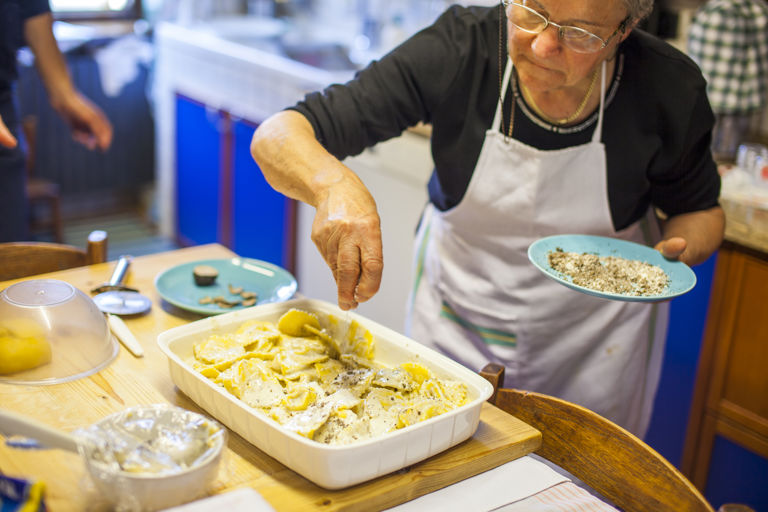Agnolotti pasta with potato, Parmigiano Reggiano and Fragno black truffle
- medium
- 12
- 4 hours
Learn how to make beautiful, handmade pasta parcels stuffed with potato, Parmigiano Reggiano and perfumed black truffle, enriched with a deeply creamy, earthy sauce – made with love, care and extraordinary hospitality.
One of the most remarkable, most memorable meals I had during my time in northern Italy was agnolotti, stuffed pasta parcels typical in the Piedmont region, an area to the west of where I was staying in Calestano, in Emilia-Romagna. Pasta stuffed with potato – double carbohydrate heaven – was a popular choice in the locality, sometimes simply seasoned with plenty of Parmigiano Reggiano, sometimes with added truffle-y excitement as well. And so it was to become a popular choice with me as well. Handmade pasta, truffle and cheese infused stuffing, a breathtakingly rich cream sauce with lashings of added butter and fresh, local black truffle. Complete and utter bliss . . . Adriana, a native of the area with many decades of culinary experience, taught me what she knew about these little parcels of joy.
The first step in executing this wonderful dish is making your preparato – an essential ingredient in the local cuisine. Made with varying proportions of finely grated Parmigiano Reggiano and black truffle, this mixture is stored in the freezer, extending the truffle season right through the year. Truffle is a notoriously difficult ingredient to store, its distinctive aroma lost as soon as any processing is applied to it. But the fats in Parmigiano Reggiano cling to the truffle's volatile aroma compounds, helping capture that ephemeral, highly prized flavour. This mixture perfumes the potato filling and the luscious cream sauce, as well as being liberally sprinkled on top, bringing the flavour of last year's truffles to my grateful lips.
The pasta should be made with particular eggs – with the deepest yellow yolks you can find. Italians like their fresh pasta to look richly yellow, and for this the yolks are key. Kneading the dough is also important – Adriana told me 'your hips should move from side to side as you press down with one hand, then the other, otherwise you're 'not doing the right dance!'
For me, making a dish such as handmade pasta truly represents what I love about cooking. You can buy a packet of processed tortellini for less than a pound, but the calm, rhythmic, sociable labour of making agnolotti with loved ones, for loved ones, trades that convenience for craft, well-being and strong social bonds – a worthy exchange.
All images courtesy of John Holdship unless otherwise credited
Ingredients
Metric
Imperial
Fresh pasta
Preparato
- 100g of black truffle, (preferably Frango truffle), grated
- 100g of Parmesan, finely grated
Pasta filling
- 1kg floury potatoes
- 200g of Parmesan, finely grated
- 2 eggs
- 20g of butter
- 1 pinch of fine sea salt
- extra virgin olive oil
Cream and truffle sauce
- 150g of butter
- 500ml of single cream
- 1 tbsp of cream cheese, heaped
- 1/2 tsp potato starch
- 100ml of whole milk
- 50g of Parmesan
- fine sea salt
Method
Get in touch
Please sign in or register to send a comment to Great British Chefs.



